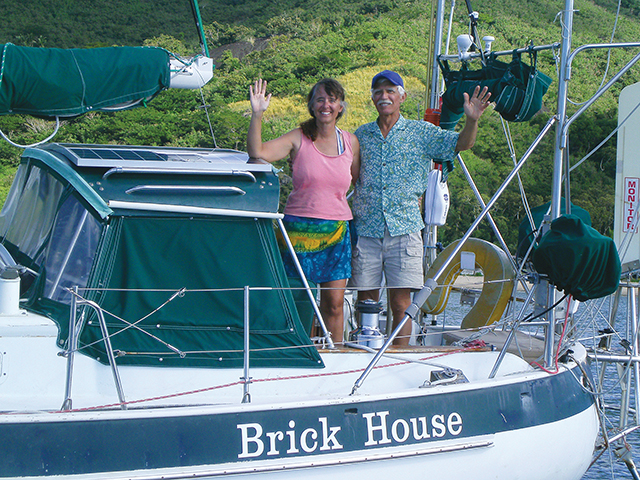Gear and personal cruising items that have kept us safe, happy and healthy after six years of world cruising (published October 2013)
Cruising into our sixth year of exploring oceans, we have had little go wrong. But now, when we anchor in a location with good mail service from the U.S., we practice preventative replacement before aging equipment has a chance to fail. And the money we choose not to throw at an insurance company allows us to invest in our boat and personal gear.
Here is a list of boat gear and everyday use items that we have found useful over thousands of miles of cruising.
Tacktick/Raymarine Instruments
Six years ago I was not about to go through all the trouble to string wires down our mast so we could know what the wind was blowing. Instead, I simply bolted a Tacktick wind speed and direction transmitter to the top of our mast. The wind receiver/display operates on its own solar powered battery so it can be mounted anywhere on or inside our boat. If desired, there is a way to connect the display to a DC 12 volt source. Additionally, we have Tacktick wireless instruments in the cockpit to show water depth and boat speed information. Tacktick has been a big success for us.
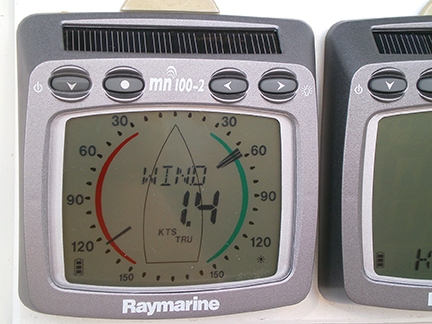 After all this time, only the wind display was fading in visibility so it has been replaced. The new display no longer has the Tacktick logo, but the Raymarine insignia as Raymarine Wireless Instruments has taken over Tacktick. We have a lot of Raymarine electronics aboard Brick House (C80 chartplotter, Radar, Type 2 linear drive Autopilot). These continue to work well for us after so many years and tens of thousands of miles. www.raymarine.com.
After all this time, only the wind display was fading in visibility so it has been replaced. The new display no longer has the Tacktick logo, but the Raymarine insignia as Raymarine Wireless Instruments has taken over Tacktick. We have a lot of Raymarine electronics aboard Brick House (C80 chartplotter, Radar, Type 2 linear drive Autopilot). These continue to work well for us after so many years and tens of thousands of miles. www.raymarine.com.
Man Overboard
I am a sailor who has crossed many oceans yet has a constant fear of falling overboard. I do believe in purposeful movement and a strong grip on the boat as I move about the deck. Only in the most violent weather do I wear a harness and tether. Such equipment has tripped me, choked me and generally been a danger in mild weather. But of course, an accident can happen at any time.
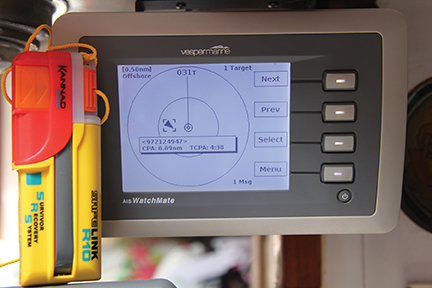 In the past, going overboard at sea meant you were good as gone, but wearing our new Kannad Safelink R-10 personal AIS locator at least provides us with some hope of recovery. Activated by the victim, the R-10 will sound an alarm on our AIS (Automatic Identification System) screen. On newer AIS screens, rather than a vessel icon, a unique man overboard icon will be displayed. GPS coordinates will be shown as long as the R-10 is transmitting, which is generally up to 24 hours. We use a splitter on our mast mounted VHF antenna to serve our radio and AIS receiver. That 50-foot height above the water gives the AIS a visual range of eight miles to the R-10 that is strapped to the person in the water. Maybe falling overboard doesn’t have to be an automatic death sentence anymore. www.kannadmarine.com.
In the past, going overboard at sea meant you were good as gone, but wearing our new Kannad Safelink R-10 personal AIS locator at least provides us with some hope of recovery. Activated by the victim, the R-10 will sound an alarm on our AIS (Automatic Identification System) screen. On newer AIS screens, rather than a vessel icon, a unique man overboard icon will be displayed. GPS coordinates will be shown as long as the R-10 is transmitting, which is generally up to 24 hours. We use a splitter on our mast mounted VHF antenna to serve our radio and AIS receiver. That 50-foot height above the water gives the AIS a visual range of eight miles to the R-10 that is strapped to the person in the water. Maybe falling overboard doesn’t have to be an automatic death sentence anymore. www.kannadmarine.com.
SeaLife Underwater Cameras
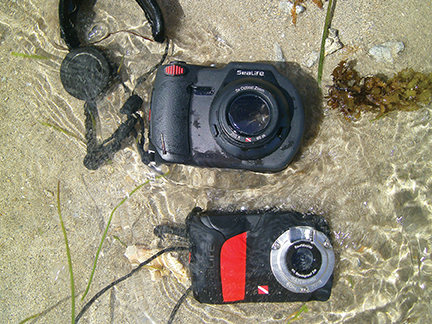 Since I found the SeaLife DC1400, I’ve realized that I don’t need thousands of dollars worth of cumbersome underwater camera equipment. The camera, which slips into the housing, has a 14 mega pixel image sensor that is capable of producing magazine quality images. In fact, all the pictures in this article were taken with the DC1400. It has a 5x optical zoom and the independent housing is rugged and can easily suffer being dropped on a hard surface or run over by a truck. Also, it is safe to use to a depth of 200 feet. The shutter and other control buttons are large and easy to use even when wearing diver’s gloves. There are plenty of optional add-ons, but I kept it simple by choosing the 111-degree angle of view, Fisheye Wide Angle Lens for macro images. The whole package fits in its own padded case and is compact enough to store on our ever-shrinking 40-foot sailboat. We bought the whole kit, except the fisheye lens, online for $500.
Since I found the SeaLife DC1400, I’ve realized that I don’t need thousands of dollars worth of cumbersome underwater camera equipment. The camera, which slips into the housing, has a 14 mega pixel image sensor that is capable of producing magazine quality images. In fact, all the pictures in this article were taken with the DC1400. It has a 5x optical zoom and the independent housing is rugged and can easily suffer being dropped on a hard surface or run over by a truck. Also, it is safe to use to a depth of 200 feet. The shutter and other control buttons are large and easy to use even when wearing diver’s gloves. There are plenty of optional add-ons, but I kept it simple by choosing the 111-degree angle of view, Fisheye Wide Angle Lens for macro images. The whole package fits in its own padded case and is compact enough to store on our ever-shrinking 40-foot sailboat. We bought the whole kit, except the fisheye lens, online for $500.
But we also needed a rugged, waterproof, compact camera to slip into a pocket or backpack, or in our dinghy to keep close at hand for snorkeling or hiking adventures to Pacific island waterfalls. For that we opted to go with the SeaLife ReefMaster Mini digital underwater dive camera as our pocket camera. It has a nine mega pixel sensor. Like the DC1400, the ReefMaster has exposure and color corrections for snorkeling and deeper diving, video mode and all the necessary features one would need. Also, the ReefMaster comes with an external mount wide-angle lens.
We are hoping waterproof cameras will survive the sailing environment better, since the internal elements of our $1,000 per lens SLR camera lenses quickly mildew to the point of destruction and the manufacturer of those brand name lenses do not always honor their warranty. www.sealife-cameras.com.
KISS Propeller Blades
There is no way of telling how many millions of revolutions our KISS wind generator has spun over the past six years. Yet, the only maintenance required was to the blades. Two years after installing our KISS I began painting the fiberglass blades to prevent surface and leading edge deterioration due to UV sunrays and general air friction. After painting, the balance of the blades was checked and fine-tuned. During the annual touchup painting, short hairline cracks at the root of two blades were discovered. The blades did not appear ready to fail but there was no certainty how much longer they would last. So we installed three new blades of the original design after painting and carefully balancing them. The newest blades supplied by KISS are made in the USA. They come pre-balanced, have a two-part polyurethane finish and helicopter tape on the leading edge. www.svvhotwire.com.
Water filter
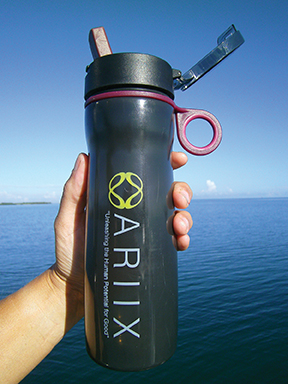 On long day trips away from our boat, we cannot always carry enough of our fresh boat water to last the day. But drinking water from a village source or from a clear stream or even from a south of the boarder city water supply is risky business. Using the PathoScreen test packet, made by the Hach Company, I find many of these water sources to be contaminated with fecal related pathogens. To help insure our good health, we began experimenting with the ARIIX (also known by the name Puritii), a one liter squeezable plastic bottle (stainless steel bottles are also available). Sipping through the mouthpiece, the water first passes through a three way internal filter. The system reportedly filters out at least 99.993 percent of bacteria, protozoa, viruses and parasites. When it becomes difficult to draw water from the bottle, it is time to change the filter. But that would take about 300 filter cycles, when used with a relatively “clean” water source. This filter is not to be used with seawater. We should be able to drink healthy water no matter what village, waterfall or restaurant we are visiting. www.ariix.com/product/remerton.
On long day trips away from our boat, we cannot always carry enough of our fresh boat water to last the day. But drinking water from a village source or from a clear stream or even from a south of the boarder city water supply is risky business. Using the PathoScreen test packet, made by the Hach Company, I find many of these water sources to be contaminated with fecal related pathogens. To help insure our good health, we began experimenting with the ARIIX (also known by the name Puritii), a one liter squeezable plastic bottle (stainless steel bottles are also available). Sipping through the mouthpiece, the water first passes through a three way internal filter. The system reportedly filters out at least 99.993 percent of bacteria, protozoa, viruses and parasites. When it becomes difficult to draw water from the bottle, it is time to change the filter. But that would take about 300 filter cycles, when used with a relatively “clean” water source. This filter is not to be used with seawater. We should be able to drink healthy water no matter what village, waterfall or restaurant we are visiting. www.ariix.com/product/remerton.
Backpack
We have torn through a lot of backpacks and have found the failure point is most often where the shoulder strap meets the back panel. When replacing them we figured that we wanted a pack that was durable and also waterproof to protect clothes and expensive gear while hiking wet trails or dodging sea spray in the dinghy. After a long search, we finally found the pack that truly suits a Pacific cruiser; the Aquanot, manufactured and distributed by Seattle Sports Company.
The comfortable, wide shoulder straps are well secured to the airflow design back panel that dissipates body heat. Additional straps spread the load from the shoulder straps to other attachment points on the pack: A chest strap keeps the shoulder straps from working their way off the shoulders and a belly strap eliminates the pack from flopping around. There are mesh pockets on each side of the pack and a larger crisscross tie down on the back. The top closure can be secured by simply folding over and securing a Velcro strap for general use or simple rain shedding. The other closing option is to roll and buckle the closure for complete water tightness.
What really makes this backpack strong and unique is that it is made of PVC coated nylon. The seams are chemically fastened, which is far stronger and more waterproof than stitching.
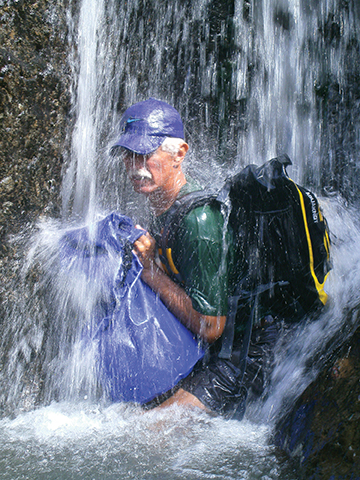 For the times when we need to get other gear, books, clothes etc, safely to shore or through rain showers, we dig out the large Seattle Sport Company ‘Explorer’ bag. The wide top opening, like on the backpack, simply folds and rolls down a couple times to make for a watertight closure. It works great for laundry too. www.seattlesportsco.com.
For the times when we need to get other gear, books, clothes etc, safely to shore or through rain showers, we dig out the large Seattle Sport Company ‘Explorer’ bag. The wide top opening, like on the backpack, simply folds and rolls down a couple times to make for a watertight closure. It works great for laundry too. www.seattlesportsco.com.
Titanium Screws
After years of dealing with rusting stainless steel fasteners that leave puddles and streaks of rust on our white decks, my final solution was to discard the stainless steel screws forever and replace them with grade two titanium screws from Allied Titanium. Grade two titanium’s yield strength is 15 percent greater than 316 stainless steel and is completely immune to sea water so they will never rust or be affected by galvanic corrosion.
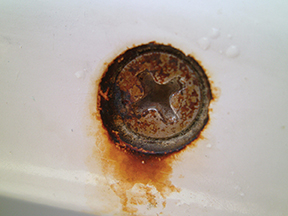 The color of titanium screws is only slightly grayer than stainless steel. The cost is two to three times that of stainless screws, but even if I had to pay a dollar each, the overall cost is negligible, especially for something that lasts and is trouble free forever. Needless to say, our titanium chainplates, mast tangs and clevis pins, continue to sparkle in the sunlight and provide our mast extra security during stormy weather. www.alliedtitanium.com.
The color of titanium screws is only slightly grayer than stainless steel. The cost is two to three times that of stainless screws, but even if I had to pay a dollar each, the overall cost is negligible, especially for something that lasts and is trouble free forever. Needless to say, our titanium chainplates, mast tangs and clevis pins, continue to sparkle in the sunlight and provide our mast extra security during stormy weather. www.alliedtitanium.com.
Patrick and Rebecca are currently exploring active volcanoes, waterfalls and primitive villages in Vanuatu before moving on to the Micronesian island of Pohnpei, north of the equator, for the upcoming cyclone season.
















